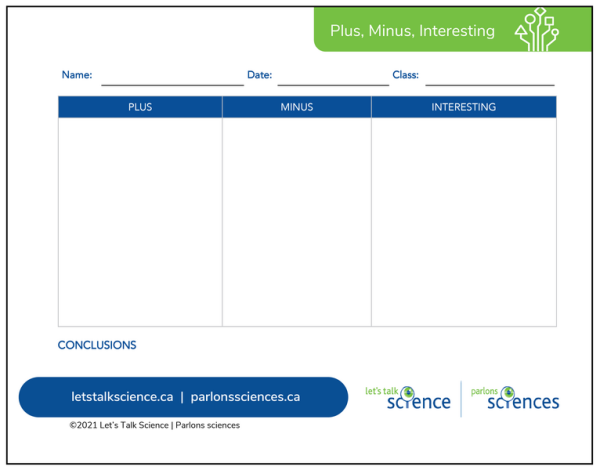Plus, Minus, Interesting

Thumbs up and down hands and magnifying glass (Let’s Talk Science)

Thumbs up and down hands and magnifying glass (Let’s Talk Science)
How does this align with my curriculum?
AB
8
Career and Technology Foundations (CTF) (revised 2019)
CTF is planning, creating, appraising and communicating in response to challenges.
AB
11
CTR2010: Job Maintenance (2016)
Job Maintenance
AB
9
Career and Technology Foundations (CTF) (revised 2019)
CTF is planning, creating, appraising and communicating in response to challenges.
MB
12
Grade 12 Career Development: Life/Work Transitioning (2017)
Unit 1: Personal Management
MB
9
Grade 9 Career Development: Life/Work Exploration (2017)
Unit 1: Personal Management
MB
10
Grade 10 Career Development: Life/Work Planning (2017)
Unit 1: Personal Management
MB
11
Grade 11 Career Development: Life/Work Building (2017)
Unit 1: Personal Management
This learning strategy helps students examine ideas, concepts, and experiences from more than one perspective before drawing conclusions or making decisions.
Why use it?
- To enhance critical thinking skills
- To identify and consider different perspectives on a topic, idea or concept
- To support innovation and creativity
- To enhance effective communication skills
Tips for success
- Provide students with the template prior to starting the discussion, reading the article or viewing the resources.
- Choose topics, ideas or concepts that encourage different viewpoints; students can critically examine texts, analyze the implications or consequences of actions and/or stimulate the sharing of various thoughts and ideas.
How do I use it?
- Consider a topic, idea or concept for discussion that you would like the students to think about from various perspectives.
- Divide students into pairs or small groups to brainstorm responses to the prompts for the steps below:
- STEP 1 - P: What are all of the positive points you can think of?
- In this step, students list all of the positive things. Ensure students don’t critique themselves but brainstorm all the positive points on the topic that they can think of.
- STEP 2 - M: What are the negative points you can think of?
- In this step, students list all of the negative things. Remind students not to critique themselves but remain focused on the negative points on the topic they can think of.
- STEP 3 - I: What are the interesting points to which you should pay attention to?
- In this step, students list everything they find interesting on the topic. Ensure students focus on points of interest that they should direct their attention to.
- STEP 4: Determine a conclusion after considering the points above.
- In this step, students make their conclusion after reviewing the positive, negative and interesting aspects on the topic.
- STEP 1 - P: What are all of the positive points you can think of?
Variations
- You may want to engage in this process as a whole class discussion instead of pairs or small groups.
- You can also have students use different colours or sticky notes instead of using the template.
Extensions
- The PMI strategy is also valuable when examining solutions to scenarios or problem based learning. It can also help to establish what is already known or understood about a topic, idea or concept. Use this strategy when you find students are rushing to conclusions without talking through the problem or issue.
Using this Strategy
- Plus, Minus, Interesting reproducible [Google doc] [PDF]
Create Your Own
- Plus, Minus, Interesting reproducible [Google doc] [PDF]
References
- Adapted from Virtual Library (n.d.) PMI - Plus, Minus, Interesting.
